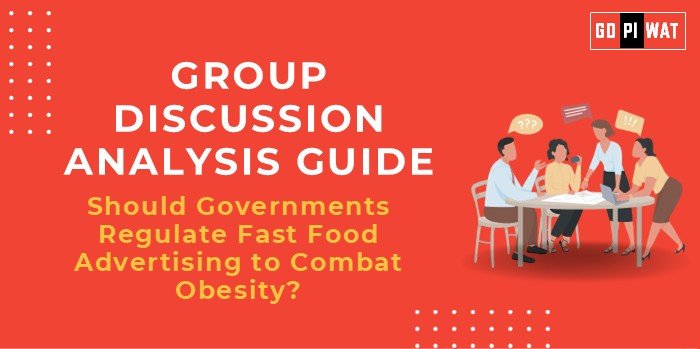📋 Group Discussion Analysis Guide: Should Governments Regulate Fast Food Advertising to Combat Obesity?
🌐 Introduction to the Topic
Opening Context:
Obesity has emerged as a global public health crisis, with fast food advertising often blamed for its rising prevalence. Governments worldwide are debating whether regulation can curb its impact.
Topic Background:
Fast food advertisements, particularly those targeting children, often promote unhealthy eating habits. The growing rates of obesity, especially among youth, have prompted calls for stricter advertising regulations. Countries like the UK and Chile have already implemented such measures, making this a hot topic for public policy discussions.
📊 Quick Facts and Key Statistics
- 🌍 Global Obesity Rates: Over 1 billion people are obese globally, including 39 million children (WHO, 2023).
- 📺 Advertising Exposure: Children view over 7,600 food ads annually, 84% of which promote junk food (US CDC, 2023).
- 💰 Economic Cost of Obesity: $2 trillion annually worldwide, accounting for 2.8% of the global GDP (McKinsey, 2023).
- 📉 Advertising Restrictions: Countries like Chile have reduced child-targeted ads by 80% since implementing strict laws in 2016.
👥 Stakeholders and Their Roles
- 🏛️ Governments: Regulate and enforce advertising norms; educate the public on healthy eating.
- 🍔 Fast Food Companies: Adjust marketing practices; promote healthier menu options.
- 🛍️ Consumers: Advocate for transparency and make informed choices.
- 🩺 Healthcare Systems: Manage obesity-related illnesses and champion preventive health measures.
- 🌍 NGOs and Advocacy Groups: Raise awareness and lobby for stricter advertising regulations.
🏆 Achievements and Challenges
✨ Achievements:
- 🇨🇱 Chile’s Success: 80% reduction in child-targeted ads; 24% decline in sugary drink consumption.
- 🇬🇧 UK’s Ad Ban: Reduced fast food TV ads during children’s programs by 37%.
- 🥗 Healthier Menus: Global brands like McDonald’s introduced lower-calorie meals following public pressure.
⚠️ Challenges:
- 🔍 Loopholes in Regulation: Ads shift to social media platforms targeting minors.
- 🏛️ Economic Resistance: Food industry lobbying delays policy implementation.
- 🌏 Cultural Barriers: Resistance to limiting food choices in regions where fast food is seen as aspirational.
🌍 Global Comparisons:
- 🇨🇱 Chile: Pioneered ad bans targeting children under 14.
- 🇺🇸 US: Focuses on voluntary measures and public education campaigns.
📚 Case Studies:
- 🇨🇱 Chile’s Law on Food Labeling and Advertising: Demonstrated reduced obesity rates in school-aged children within 5 years.
💬 Structured Arguments for Discussion
- ✔️ Supporting Stance: “Regulating fast food ads is essential to protect public health, especially children.”
- ❌ Opposing Stance: “Restricting ads infringes on free market rights and personal choice.”
- 🔄 Balanced Perspective: “A balanced approach of regulation and public education is the most sustainable solution.”
🎯 Effective Discussion Approaches
🚀 Opening Approaches:
- 📊 Statistical Impact: “Globally, obesity costs $2 trillion annually—could regulation reduce this burden?”
- 📚 Case Study: “Chile’s advertising ban led to significant reductions in unhealthy food consumption among children.”
💡 Counter-Argument Handling:
- ✔️ “While personal choice is vital, targeted ads exploit vulnerabilities, especially in children who lack decision-making skills.”
🔍 Strategic Analysis of Strengths and Weaknesses
- 💪 Strengths: Reduced health costs; improved public health outcomes.
- ⚖️ Weaknesses: Resistance from industry stakeholders; enforcement challenges.
- 🌱 Opportunities: Drive innovation in healthier fast food options.
- ⚠️ Threats: Potential backlash from businesses and consumers.
🎓 Connecting with B-School Applications
🌐 Real-World Applications:
- 📈 Explore public-private partnerships in creating healthier fast food alternatives.
🤔 Sample Interview Questions:
- ❓ “How can governments balance public health and corporate freedoms?”
- ❓ “Analyze the economic impact of fast food advertising regulations.”
💡 Insights for B-School Students:
- 🔍 Policy-making strategies.
- 📊 Insights into corporate social responsibility.


